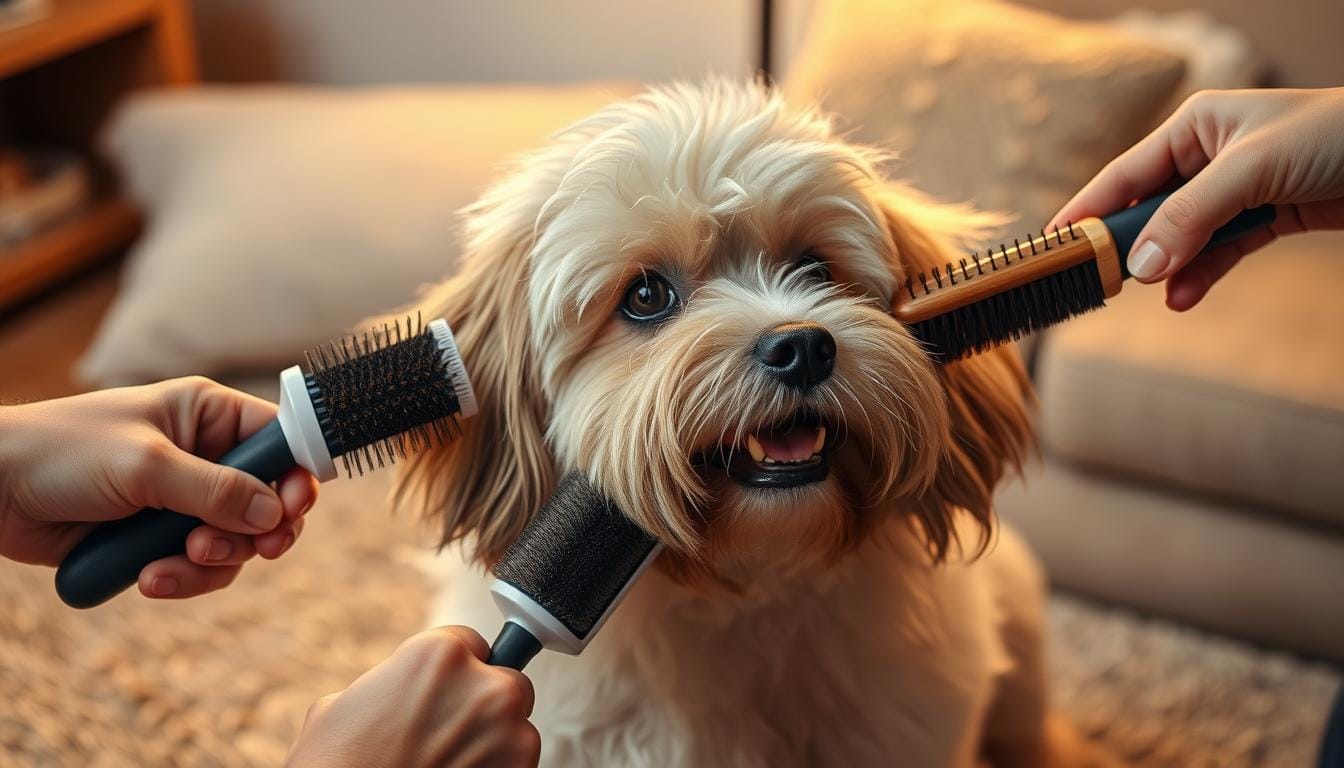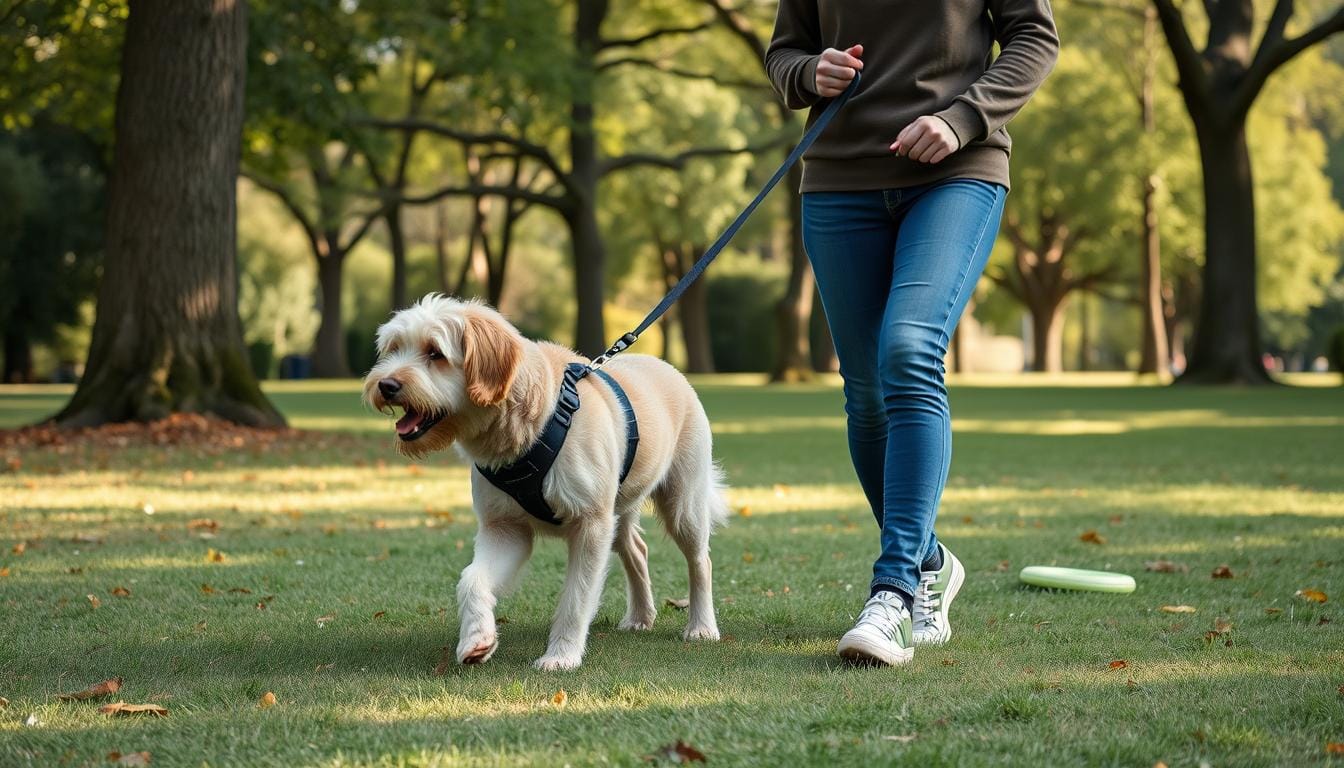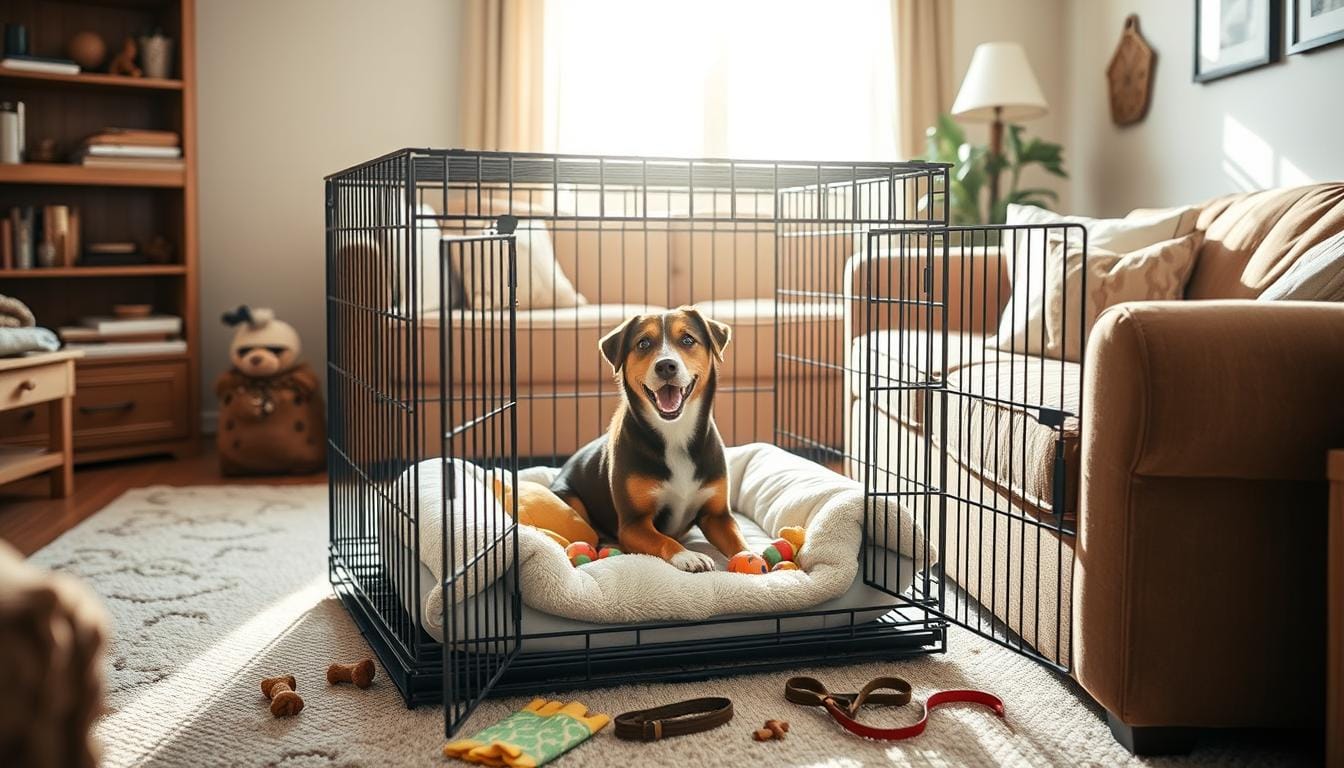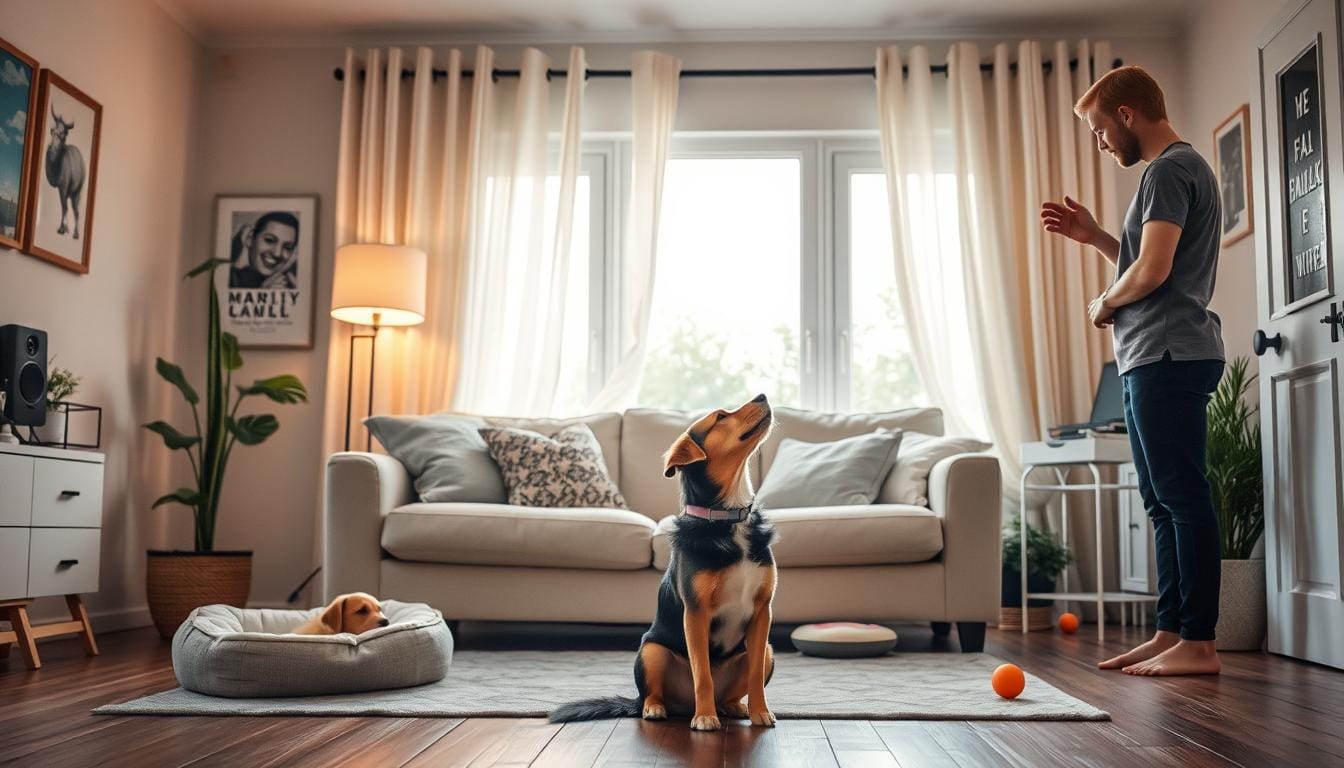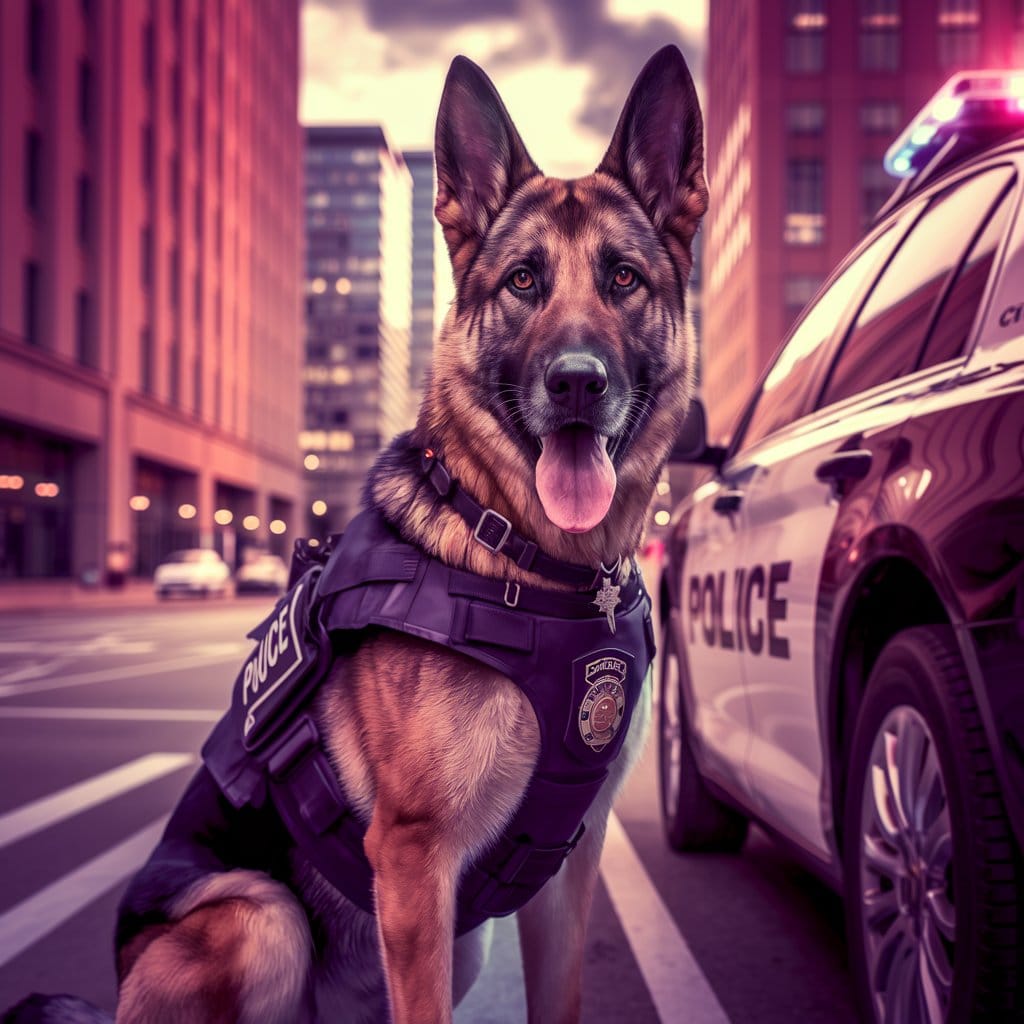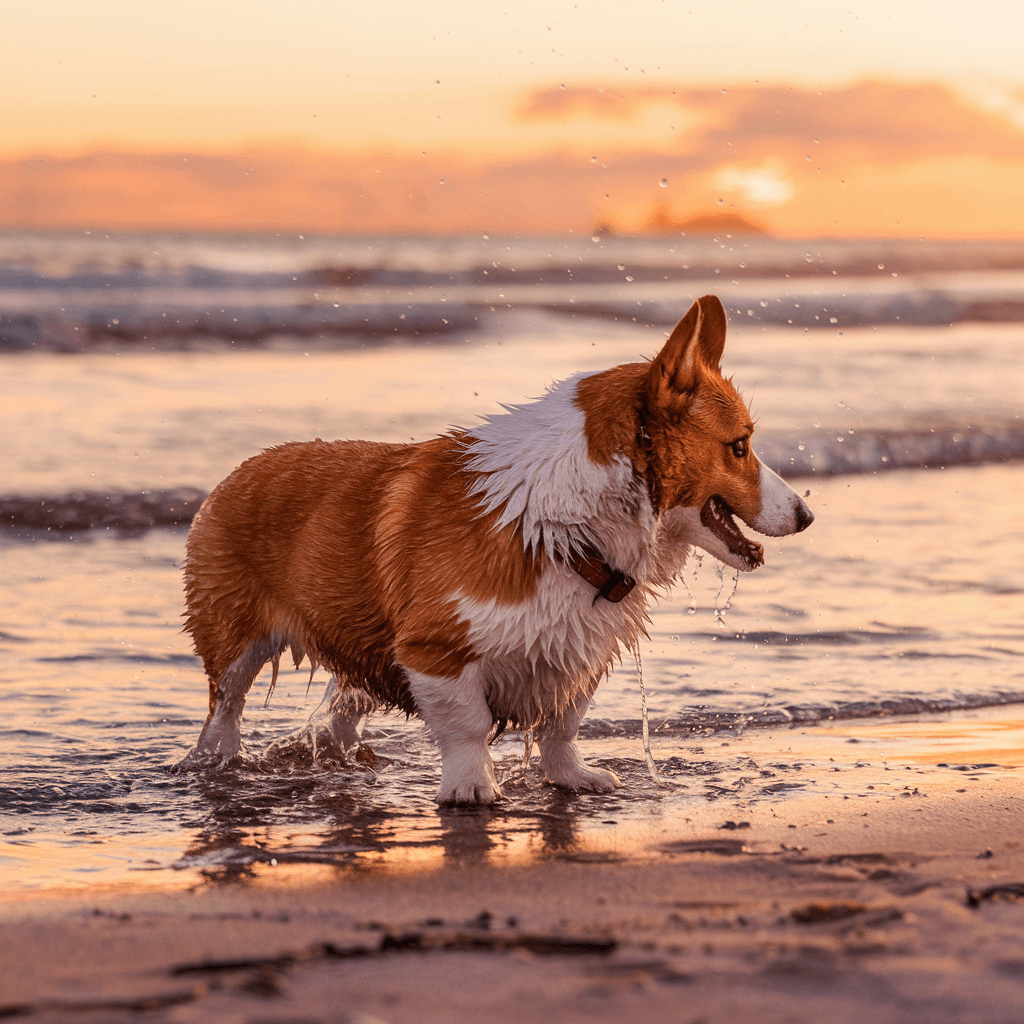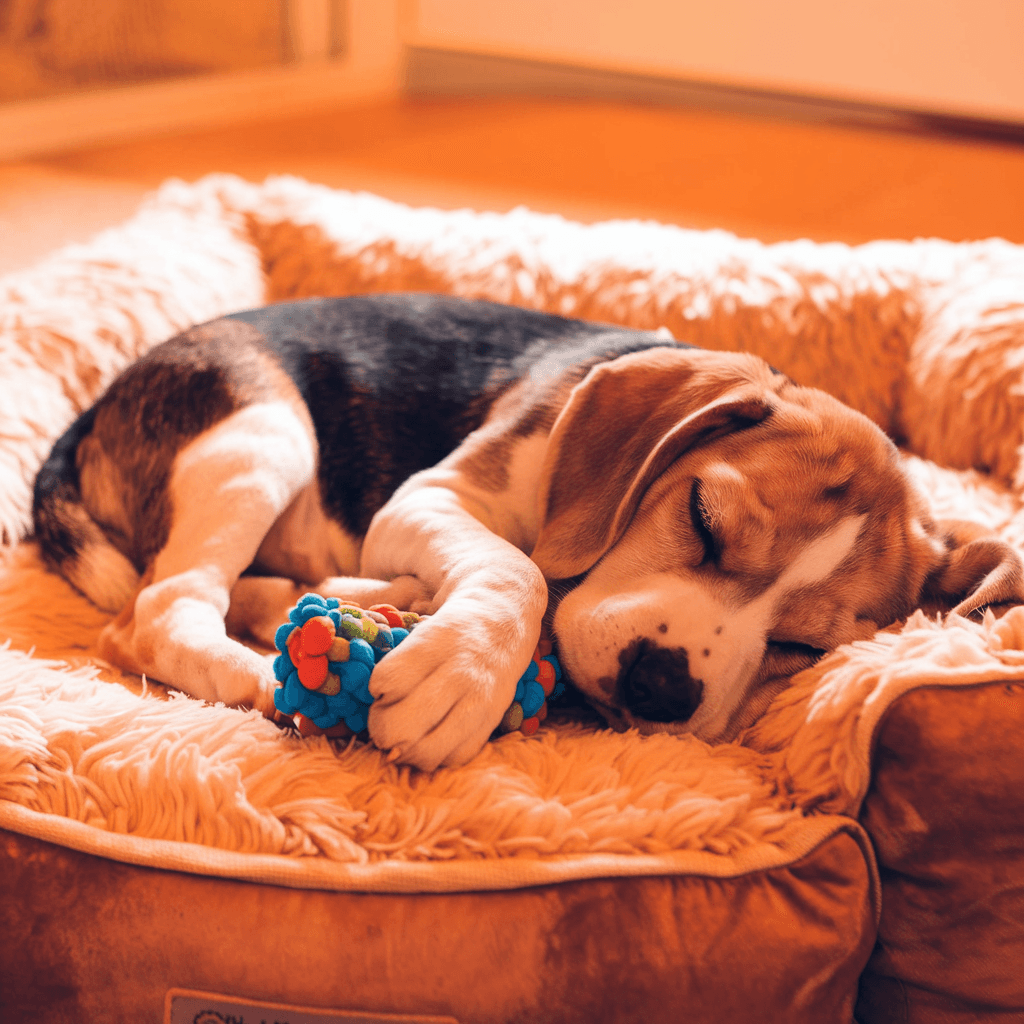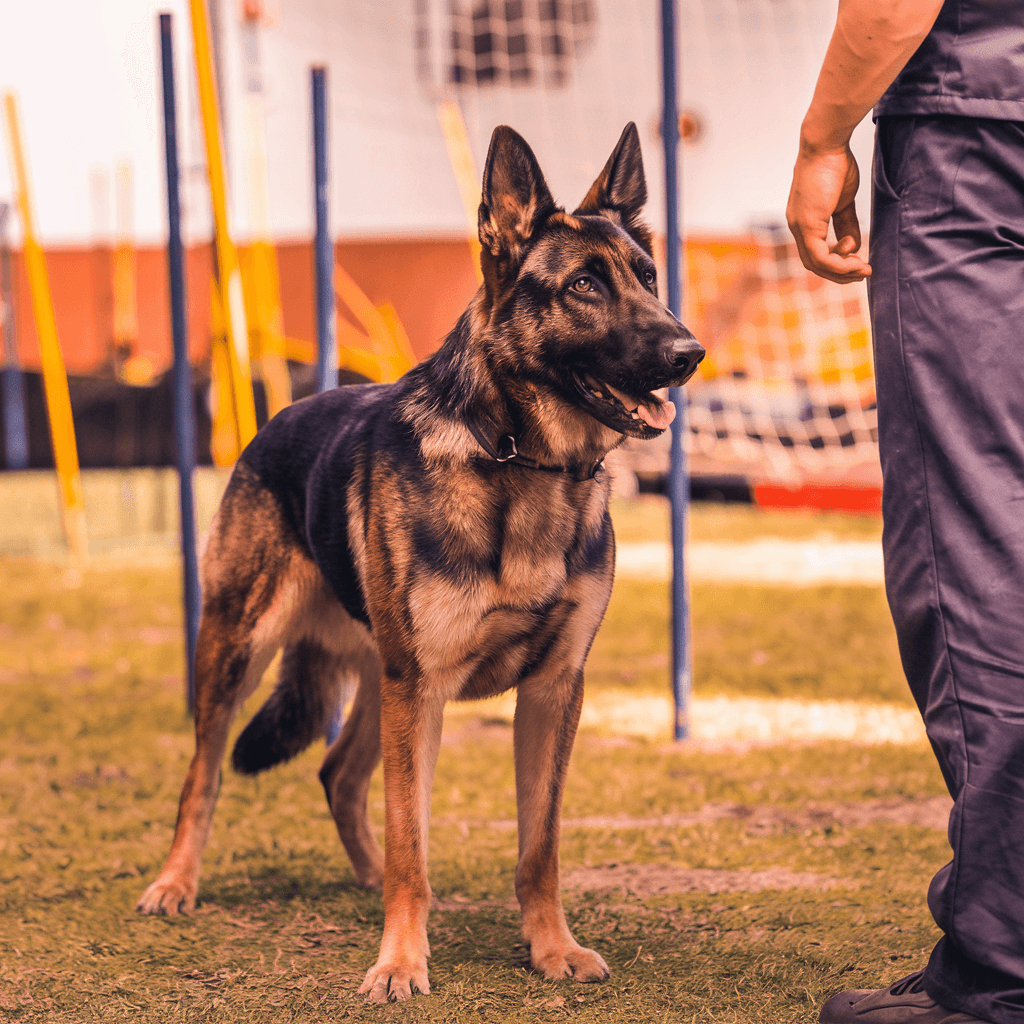Is your dog’s coat looking less than perfect? We’re here to help you pick the ideal brush for their needs. Choosing the right dog grooming brushes is crucial for your pet’s coat care and overall health. With the right pet grooming tools, you can keep your furry friend looking and feeling their best.
Proper coat care goes beyond just appearances. Regular brushing removes dirt and dead hair, allows for skin inspection, and creates a bonding experience with your pet. It’s wise to start brushing puppies early with soft brushes to get them used to the process.
Different coat types require specific dog grooming brushes. For instance, slicker brushes work well for medium to long-coated breeds, while bristle brushes suit short-coated dogs. Understanding your dog’s coat texture is key to selecting the right pet grooming tools.
Remember, the size of the brush matters too. Choose a brush that fits comfortably in your hand and is appropriate for your dog’s size. This ensures effective coat care and a pleasant grooming experience for both you and your pet.
Key Takeaways
- Regular brushing improves coat health and strengthens the bond with your pet
- Different coat types require specific brush types
- Brush size should match your dog’s size for effective grooming
- Start grooming puppies early to establish a routine
- Proper coat care helps prevent skin issues and reduces shedding
Understanding the Importance of Regular Dog Brushing
Brushing your dog regularly is more than just making them look good. It’s key to keeping them healthy and happy. Let’s look at why this grooming is so important.
Benefits for Your Dog’s Health
Brushing your dog often has many health benefits. It gets rid of dirt, debris, and dander, which can cause skin problems. Tools like slicker brushes and dematting rakes help untangle fur and remove loose hair, preventing mats.
- Prevents skin infections
- Removes dirt and debris
- Detangles fur
- Reduces shedding
Impact on Coat Maintenance
Brushing regularly keeps your dog’s coat healthy and shiny. It spreads natural oils, making the fur glossy and the skin healthy. Long-haired dogs need brushing every 4-6 weeks, while short-haired ones can go 6-12 weeks.
Building the Bond with Your Pet
Grooming is a great time to bond with your dog. It’s a chance to check for skin issues or parasites while making them feel loved. Using the right tools, like a shedding blade or slicker brush, makes grooming fun for both of you.
| Grooming Frequency | Coat Type | Recommended Tools |
|---|---|---|
| Every 4-6 weeks | Long-haired | Slicker brush, Dematting rake |
| Every 6-12 weeks | Short-haired | Shedding blade, Bristle brush |
| Weekly | All coat types | Slicker brush, Grooming mitt |
By brushing your dog regularly, you’re doing more than just keeping them looking good. You’re also helping their health and happiness.
Dog grooming brushes, coat care, pet grooming tools
Choosing the right dog brush is key to your pet’s coat health. We’ve looked at different grooming tools to find the best for your furry friend. Each brush, from undercoat rakes to deshedding tools, has its own role in coat care.
Undercoat rakes are vital for double-coated breeds. They remove loose fur from the undercoat. Deshedding tools help by taking out loose hair before it falls on your furniture. A standard dog brush is great for daily grooming, keeping your pet’s coat clean and free of tangles.
Now, let’s check out some popular grooming tools and their prices:
| Product Name | Price |
|---|---|
| Tauro Pro Line Ergonomic Non-Slip Wooden Round Dog & Cat Brush | $29.99 |
| Tauro Pro Line Ergonomic Classic Wooden Slicker Dog & Cat Brush | $35.99 |
| Tauro Pro Line Ergonomic Non-Slip Wooden Rectangular Dog & Cat Brush | $23.99 |
| Tauro Pro Line Wooden Massage Oblong Dog & Cat Brush | $21.99 |
| Tauro Pro Line Ergonomic Plastic Dog & Cat Brush with Curved Stainless Steel Teeth | $9.99 |
When picking a grooming tool, think about your dog’s coat type and size. Long-haired breeds might need a slicker brush, while short-haired dogs could prefer a bristle brush. Quality grooming tools save you time and money over time.
Different Types of Dog Coat Textures
Knowing your dog’s coat type is key for good coat care and the right grooming tools. We’ll look at different coat textures and what they need.
Short-Coated Breeds
Breeds like Beagles and Labrador Retrievers have hair that’s close to their body. They don’t need much grooming. A weekly brush with a bristle brush keeps their coat shiny and healthy.
Long-Coated Breeds
Maltese and Shetland Sheepdogs have long fur that can reach the floor. They need daily grooming to avoid tangles. Slicker brushes and pin brushes are must-haves for these breeds.
Double-Coated Breeds
Dogs like Huskies and Pomeranians have double coats. They need brushing 1-3 times a week to stop matting. Undercoat rakes are key grooming tools for these breeds, especially during shedding seasons.

Curly and Wire-Coated Breeds
Poodles and Portuguese Water Dogs have curly coats that need special care. They need brushing several times a week and professional grooming every 4-6 weeks. Wire-coated breeds like Schnauzers need weekly brushing with a slicker brush and regular hand stripping.
| Coat Type | Brushing Frequency | Professional Grooming |
|---|---|---|
| Short-Coated | Weekly | As needed |
| Long-Coated | Daily | Every 2-3 months |
| Double-Coated | 1-3 times per week | 3-4 times per year |
| Curly-Coated | Several times per week | Every 4-6 weeks |
| Wire-Coated | Weekly | Twice per year |
Essential Slicker Brush Guide
A slicker brush is a must-have for dog owners with medium to long-coated breeds. These brushes have short, tightly-packed wire pins. They are great for removing loose hair, tangles, and mats. Golden Retrievers and Poodles especially benefit from using a slicker brush regularly.
When brushing, use light pressure to avoid skin discomfort. The Groom Professional Curved Soft Slicker Brush is available in three sizes. It’s perfect for different coat types. For puppies and delicate coats, the Chris Christensen The Wood Pin Brush is a great option. It’s 100% static-free and prevents hair breakage.
Dog grooming brushes serve different purposes. Slicker brushes are best for longer coats, while bristle brushes are great for short-coated breeds. Bristle brushes help distribute natural oils, making the coat healthy and shiny.
| Brush Type | Best For | Features |
|---|---|---|
| Slicker Brush | Medium to Long Coats | Removes tangles and mats |
| Bristle Brush | Short Coats | Distributes oils, adds shine |
| Pin Brush | Long-Haired Breeds | Removes loose hair |
For breeds with specific grooming needs, like Terriers, the Chris Christensen Terrier Palm Pad Leather is a good choice. It has 78 ground and polished pins. Its flexible leather backing makes grooming comfortable. The Show Tech Ionic Bristle & Brass Finishing Palm Brush is also special. It combines brass and bristles for the best cleaning and shine.
Brushing frequency depends on your dog’s coat type and length. Long or thick-coated breeds may need daily brushing. Short-coated dogs need less grooming. Using the right dog grooming brushes, including a slicker brush or dematting rake, is key for coat health.
Understanding Bristle Brushes and Their Uses
Bristle brushes are key for grooming your dog’s coat. They’re great for short-coated dogs, removing loose hair and boosting skin health. Many dog owners, 41%, prefer to groom their pets at home, making these brushes a top choice.
Natural vs. Synthetic Bristles
Bristle brushes have two main types: natural and synthetic. Natural bristles, like boar hair, are softer and kinder to the skin. Synthetic bristles, usually nylon, are more durable. Both help spread natural oils, making the coat shine and reducing static.
Best Practices for Bristle Brush Use
For the best results, brush your dog’s coat when it’s clean and dry. Always brush in the direction of hair growth to prevent irritation. Regular use keeps the coat healthy and shiny. This is crucial since 23-57% of dog owners don’t have a brush.
Suitable Breeds for Bristle Brushes
Bristle brushes are perfect for breeds with smooth or short coats, like Pugs and Jack Russell Terriers. They’re also great for finishing touches on long or drop-coated breeds. Here’s a guide on coat types and the best brushes for them:
| Coat Type | Suitable Brush | Example Breeds |
|---|---|---|
| Smooth/Single-Coated | Bristle Brush | Weimaraner, Dalmatian |
| Medium-Coated | Bristle or Pin Brush | Labrador Retriever, Rottweiler |
| Double-Coated | Slicker Brush, Undercoat Rake | German Shepherd, Siberian Husky |
| Silky-Coated | Pin Brush, Bristle Brush | Cocker Spaniel, Irish Setter |
The pet grooming market is worth over $9.9 billion. Choosing the right bristle brush for your dog’s coat can greatly enhance your grooming routine and your pet’s coat health.
Mastering the Undercoat Rake
The undercoat rake is key for double-coated breeds. It has metal pins that go through thick coats. This makes it perfect for dogs like German Shepherds and Huskies.

When picking an undercoat rake, think about the pin length. Longer pins are best for thick coats. Shorter ones are better for medium-length fur. The right length helps remove loose undercoat without hurting your pet.
To use an undercoat rake well:
- Start with gentle pressure to avoid skin irritation
- Work in sections, focusing on one area at a time
- Brush in the direction of hair growth
- Pay extra attention to areas prone to matting
Regular use of an undercoat rake stops matting and cuts down on shedding. It’s especially helpful during seasonal coat changes when dogs shed more.
| Coat Type | Recommended Rake Pin Length | Brushing Frequency |
|---|---|---|
| Short Double Coat | Short (0.5-1 inch) | 1-2 times per week |
| Medium Double Coat | Medium (1-1.5 inches) | 2-3 times per week |
| Long Double Coat | Long (1.5-2 inches) | 3-4 times per week |
Adding an undercoat rake to your grooming routine keeps your dog’s coat healthy. It also cuts down on shedding. Plus, it strengthens your bond through regular grooming.
Pin Brushes: Features and Applications
Pin brushes are key for dog grooming, looking like human hairbrushes. They have wire pins with soft tips, which are gentle on your dog’s skin. Let’s look at their design, how to use them, and the best coat types for pin brushes.
Design Elements
Pin brushes come in many sizes and shapes for different dog breeds. They usually have a flat or slightly curved head with straight pins. Some have ball-tipped pins for extra comfort. The Chris Christensen Original Series Oval Brush is a top pick, available in three pin lengths:
- 20mm for short coats
- 27mm for medium to long coats
- 35mm for long, thick, full coats
Proper Usage Techniques
To use a pin brush right, follow these steps:
- Start at the head and work down the body
- Brush in the direction of hair growth
- Use gentle, long strokes to remove loose dirt and debris
- Focus on areas prone to tangling
Ideal Coat Types
Pin brushes are best for dogs with medium to long coats. They’re great for:
- Detangling wire-coated breeds
- Finishing long-coated breeds after using other brushes
- Maintaining silky, flowing coats
For versatility, try a combo brush like the Hartz Groomer’s Best. It has stainless steel pins on one side and soft nylon bristles on the other. It’s good for many coat types.
Rubber Brushes and Grooming Mitts
Rubber brushes and grooming mitts are key for coat care, especially for short-haired breeds. They offer benefits that regular brushes can’t.
Rubber brushes have soft bristles that gently rub your dog’s skin. They also remove loose hair. This helps blood flow and keeps the coat healthy. You can use them on both dry and wet coats, making them great for baths.
Grooming mitts let you groom your dog by hand. They’re great for dogs that are scared of brushes. Wearing a mitt, you can pet and groom at the same time. It makes grooming a positive experience for your dog.
“Using a grooming mitt feels like giving my dog a massage. He loves it, and I love how shiny his coat looks afterward!” – Sarah, dog owner
Both rubber brushes and grooming mitts spread natural oils in your dog’s coat. This adds shine and keeps the coat healthy.
| Tool | Best For | Benefits |
|---|---|---|
| Rubber Brush | Short-coated breeds | Removes loose hair, stimulates blood flow |
| Grooming Mitt | Nervous dogs, all coat types | Gentle grooming, distributes natural oils |
When picking between a rubber brush and a grooming mitt, think about your dog’s personality and coat. If your dog is nervous or new to grooming, a mitt is a gentle start. For deep de-shedding, a rubber brush is better.
Choosing the Right Brush Size
When picking the perfect dog brush, size is key. The right size ensures your dog stays comfortable and well-groomed. Let’s look at how to pick the best brush size for dogs of all sizes.
Small Dog Considerations
Small dogs need gentle grooming. For them, choose compact brushes. These allow for detailed grooming of their delicate areas. Look for soft bristles to avoid irritating their skin.
A palm-sized brush is great for Chihuahuas, Yorkies, and other small breeds.
Medium Dog Requirements
Medium-sized dogs do well with standard brushes. These are versatile for different coat types. Pick a brush with a grip that feels right in your hand.
A medium-sized slicker or pin brush is ideal for Beagles or Cocker Spaniels.
Large Dog Necessities
Big dogs need sturdy grooming tools. Large brushes cover more area, making grooming faster. Choose durable brushes for thick coats.
Wide-toothed combs and large slicker brushes are great for German Shepherds or Golden Retrievers.
The right brush size makes grooming easier and strengthens your bond with your pet. Always think about your dog’s comfort and your ease when picking grooming tools.
| Dog Size | Brush Size | Recommended Tool |
|---|---|---|
| Small | Compact | Soft bristle brush |
| Medium | Standard | Slicker or pin brush |
| Large | Large | Wide-toothed comb or large slicker brush |
Choosing the right brush size makes grooming a joy for both you and your dog.
Brush Maintenance and Care Tips
Keeping your dog grooming brushes in good shape is key for a healthy coat. Here are some tips to help you maintain your grooming tools.
Always clean your brushes after each use to get rid of hair and dirt. This keeps the brush working well. Use mild soap and warm water for cleaning, then dry it completely to avoid rust.
Sanitize your brushes often to stop bacteria from growing. This is very important if you groom many dogs. A pet-safe disinfectant spray is great for this.
Keep your grooming tools in a dry spot to prevent damage. A brush holder or storage box can help keep them organized.
| Brush Type | Cleaning Frequency | Replacement Signs |
|---|---|---|
| Slicker Brush | After each use | Bent or missing bristles |
| Bristle Brush | Weekly | Frayed or sparse bristles |
| Pin Brush | Bi-weekly | Loose or missing pins |
| Rubber Brush | After each use | Cracked or torn rubber |
Change your brushes when you see signs of wear. Look for bent bristles, loose pins, or cracked rubber. Taking care of your brushes means a happy, healthy pet.
Professional Grooming Tool Recommendations
We’ve spent over 35 years with dogs and grooming them. We’re excited to share our top picks for pet grooming tools. Whether you’re on a budget or looking for premium options, we’ve got you covered.
Budget-Friendly Options
For those watching their wallet, a basic slicker brush and a combination pin/bristle brush are great starters. These versatile dog brushes tackle most coat types. They help distribute natural oils for a healthy shine.
Premium Tool Selections
If you’re ready to invest, consider professional-grade tools. Look for ergonomic designs and self-cleaning mechanisms. Our top picks include:
- Stainless steel combs with antistatic coating
- High-quality deshedding tools for double-coated breeds
- Scissors made of 440C Japanese stainless steel for precise trimming
Must-Have Combinations
For a well-rounded grooming kit, we recommend this trio:
- A slicker brush for detangling and removing loose fur
- An undercoat rake for tackling thick undercoats
- A bristle brush for finishing and adding shine
This combination works wonders for most coat types. It ensures your pup looks and feels their best.
Remember, investing in quality pet grooming tools makes the process easier. It also makes it more comfortable for your furry friend. With the right tools, you’ll be well-equipped to keep your dog’s coat healthy and beautiful.
Conclusion
Choosing the right dog grooming brushes and tools is key for good coat care. The global pet grooming market is set to hit $14.46 billion by 2025. This shows how important grooming is for pet owners.
We’ve looked at different brush types and their uses. It’s important to pick the right brush for your dog’s coat type and length.
Brushing frequency depends on your dog’s coat. Short-haired dogs might need brushing once or twice a week. Long or thick-coated dogs need daily brushing.
For dogs with high-maintenance coats, getting a professional groom every six to eight weeks helps. Regular brushing keeps your dog looking good and boosts your bond.
When picking dog grooming brushes, think about durability and quality. Professional-grade tools might cost more but last longer and work better. There are slicker brushes for long-haired dogs and rubber brushes for short coats.
By choosing the right tools and sticking to a grooming routine, your dog will stay healthy, happy, and look great.

